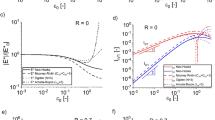Abstract
Observations are reported on a medical grade of silicone elastomer in uniaxial tensile tests up to breakage of specimens, short-term relaxation tests, and cyclic tests with monotonically increasing maximum elongation ratios. Experimental data in cyclic tests demonstrate the fading memory phenomenon: stress–strain diagrams for two specimens with different deformation histories along the first n−1 cycles and coinciding loading programs for the other cycles become identical starting from the nth cycle. A constitutive model is developed in cyclic viscoplasticity of elastomers with finite strains, and its adjustable parameters are found by fitting the experimental data. Ability of the stress–strain relations to predict the mechanical response in cyclic tests with various deformation programs is confirmed by numerical simulation.














Similar content being viewed by others
References
Curtis J, Colas A (2004) Medical applications of silicones. In: Ratner BD (ed) Biomaterials science: an introduction to materials in medicine. Elsevier, London
Mullins L (1947) Effect of stretching on the properties of rubber. J Rubber Res 16:275–289
Diani J, Fayolle B, Gilormini P (2009) A review on the Mullins effect. Eur Polym J 45:601–612
Goktepe S, Miehe C (2005) A micro-macro approach to rubber-like materials. Part III: The micro-sphere model of anisotropic Mullins-type damage. J Mech Phys Solids 53:2259–2283
Chagnon G, Verron E, Marckmann G, Gornet L (2006) Development of new constitutive equations for the Mullins effect in rubber using the network alteration theory. Int J Solids Struct 43:6817–6831
Li J, Mayau D, Lagarrigue V (2008) A constitutive model dealing with damage due to cavity growth and the Mullins effect in rubber-like materials under triaxial loading. J Mech Phys Solids 56:953–973
Cantournet S, Desmorat R, Besson J (2009) Mullins effect and cyclic stress softening of filled elastomers by internal sliding and friction thermodynamics model. Int J Solids Struct 46:2255–2264
Drozdov AD (2009) Mullins’ effect in semicrystalline polymers. Int J Solids Struct 46:3336–3345
Palmieri G, Sasso M, Chiappini G, Amodio D (2009) Mullins effect characterization of elastomers by multi-axial cyclic tests and optical experimental methods. Mech Mater 41:1059–1067
Itskov M, Ehret AE, Kazakeviciute-Makovska R, Weinhold GW (2010) A thermodynamically consistent phenomenological model of the anisotropic Mullins effect. Z Angew Math Mech 90:370–386
MacHado G, Chagnon G, Favier D (2010) Analysis of the isotropic models of the Mullins effect based on filled silicone rubber experimental results. Mech Mater 42:841–851
Ayoub G, Zairi F, Nait-Abdelaziz M, Gloaguen JM (2011) Modeling the low-cycle fatigue behavior of visco-hyperelastic elastomeric materials using a new network alteration theory: application to styrene-butadiene rubber. J Mech Phys Solids 59:473–495
Bhattacharya A, Medvedev GA, Caruthers JM (2011) Time-dependent mechanical behavior of carbon black filled elastomers. Rubber Chem Technol 84:296–324
Drozdov AD, Christiansen JdeC (2011) Mullins’ effect in semicrystalline polymers: experiments and modeling. Meccanica 46:359–370
Merckel Y, Diani J, Brieu M, Berghezan D (2011) Experimental characterization and modelling of the cyclic softening of carbon-black filled rubbers. Mater Sci Eng A 528:8651–8659
Anand L, Gurtin ME (2003) A theory of amorphous solids undergoing large deformations, with application to polymeric glasses. Int J Solids Struct 40:1465–1487
Korchagin V, Dolbow J, Stepp D (2007) A theory of amorphous viscoelastic solids undergoing finite deformations with application to hydrogels. Int J Solids Struct 44:3973–3997
Krempl E, Khan F (2003) Rate (time)-dependent deformation behavior: an overview of some properties of metals and solid polymers. Int J Plast 19:1069–1095
Khan F, Krempl E (2005) Amorphous and semi-crystalline solid polymers: experimental and modeling studies of their inelastic deformation behaviors. J Eng Mater Technol 127:64–72
Colak OU (2005) Modeling deformation behavior of polymers with viscoplasticity theory based on overstress. Int J Plast 21:145–160
Colak OU, Dusunceli N (2006) Modeling viscoelastic and viscoplastic behavior of high density polyethylene (HDPE). J Eng Mater Technol 128:572–578
Dusunceli N, Colak OU (2008) Modelling effects of degree of crystallinity on mechanical behavior of semicrystalline polymers. Int J Plast 24:1224–1242
Acknowledgements
Financial support by the EU Commission through Project Evolution-314744 is gratefully acknowledged.
Author information
Authors and Affiliations
Corresponding author
Rights and permissions
About this article
Cite this article
Drozdov, A.D., Clyens, S. & Theilgaard, N. Multi-cycle deformation of silicone elastomer: observations and constitutive modeling with finite strains. Meccanica 48, 2061–2074 (2013). https://doi.org/10.1007/s11012-013-9725-8
Received:
Accepted:
Published:
Issue Date:
DOI: https://doi.org/10.1007/s11012-013-9725-8




